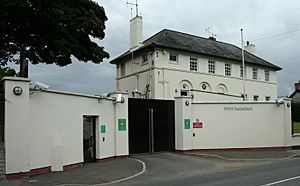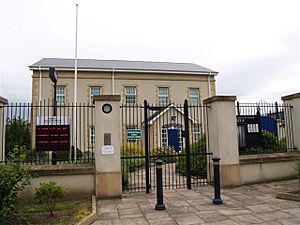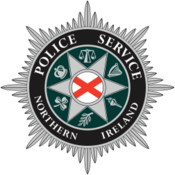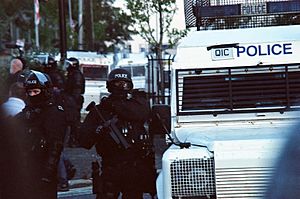Police Service of Northern Ireland facts for kids
Quick facts for kids Police Service of Northern Ireland |
|
|---|---|

The Service Emblem
|
|
| Abbreviation | PSNI |
| Motto | Keeping People Safe |
| Agency overview | |
| Formed | 4 November 2001 |
| Preceding agency | |
| Annual budget | £836.7M (FY 2014/15) |
| Legal personality | Police service |
| Jurisdictional structure | |
| National agency | Northern Ireland |
| Operations jurisdiction | Northern Ireland |
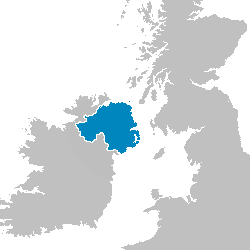 |
|
| Police Service of Northern Ireland area | |
| Size | 14,130 km2 (5,460 sq mi) |
| Population | 1,903,175 |
| Governing body | Northern Ireland Executive |
| Constituting instrument | |
| General nature | |
| Operational structure | |
| Headquarters | Belfast |
| Police officers | 6422 |
| Police civilians | 2,297 |
| Agency executives |
|
| Departments |
12
Crime Operations Department
Criminal Justice Department Human Resources Department Department of Media and Public Relations Professional Standards Department Search and Rescue Team Crime Support Department Finance and Support Services Legal Services Department Operational Support Department Rural Region Urban Region |
| Regions | 8 (11 District) |
| Facilities | |
| Stations | 32 |
| Watercrafts | Yes |
| Aircraft | 3 helicopters 1 fixed-wing |
| Dogs | 28 |
The Police Service of Northern Ireland (PSNI) is the main police force in Northern Ireland. Its job is to keep people safe and prevent crime. It was created in 2001. The PSNI took over from an older police force called the Royal Ulster Constabulary (RUC).
The PSNI is one of the largest police forces in the United Kingdom. It has many officers and covers a large area. It is also bigger than the police force in the Republic of Ireland, called Garda Síochána, in terms of the number of officers.
Contents
- How the PSNI Started
- How the PSNI is Organised
- Where the PSNI Has Power
- Who Checks the PSNI?
- Joining the PSNI
- PSNI Policies
- PSNI Structure
- Special Police Units
- Police Uniforms
- Police Equipment
- PSNI Headquarters
- Data Breach and Fine in 2023
- Chief Constables of the PSNI
- Police Ranks
- Police Fund
- See also
How the PSNI Started
As part of the Good Friday Agreement, there was a plan to create a new police service. This new service would be based on the RUC but would be reformed. An independent group, called the Patten Commission, was set up to suggest changes. Because of their suggestions, the RUC was replaced by the PSNI on November 4, 2001. The new police service was officially named the Police Service of Northern Ireland.
The RUC had many officers from a Ulster Protestant background. The PSNI has worked to include more people from all backgrounds. This was done through special policies to make the police force more diverse.
At first, Sinn Féin, a major political party, did not support the PSNI. They wanted all the suggested changes to be put in place. However, in January 2007, Sinn Féin announced they fully supported the PSNI. Now, all major political parties in Northern Ireland support the police service.
How the PSNI is Organised
The most senior officer in the PSNI is the chief constable. The Northern Ireland Policing Board chooses the chief constable. The Minister of Justice for Northern Ireland must also agree to this choice. The Chief Constable of Northern Ireland is one of the highest-paid police officers in the UK. The current chief constable is Jon Boutcher. He was officially confirmed in this role in November 2023.
Northern Ireland is divided into eight police districts. Each district is led by a chief superintendent. These districts are then split into smaller areas. Each area is managed by a chief inspector. These areas are further divided into sectors, each led by an inspector.
In 2010, the power to make decisions about policing and justice was given to the Northern Ireland Assembly. However, the chief constable still leads and controls the PSNI.
There are also other police groups in Northern Ireland. They are responsible for specific transport areas. These include the Belfast Harbour Police and the Belfast International Airport Constabulary.
Where the PSNI Has Power
PSNI officers have full police powers across all of Northern Ireland. They also have powers in the nearby waters of the United Kingdom. In other parts of the UK, like England and Wales or Scotland, their powers are more limited. This is unless they are helping other police forces.
Police staff also work for the PSNI. They help with office work, support operations, and sometimes work on the front lines.
Working with Garda Síochána
The Patten Report suggested that the PSNI and the Garda Síochána should work together. The Garda Síochána is the police force in the Republic of Ireland. This idea was put into action in 2002. It allowed police officers to be exchanged between the two services.
There are different ways officers can be exchanged. Some exchanges are for up to one year, where officers learn from each other. Other exchanges, called secondments, can last up to three years. During secondments, officers have full policing powers.
Who Checks the PSNI?
The Northern Ireland Policing Board watches over the PSNI. They make sure the police force is doing its job well.
If someone has a complaint about the PSNI, they can go to the Police Ombudsman for Northern Ireland. The Ombudsman investigates any claims of bad behaviour by police officers. The current Police Ombudsman is Marie Anderson.
The PSNI also has its own department that checks on its officers. This is called the Professional Standards Department. They look into smaller issues and more serious misconduct. If an officer is found to have done something wrong, they could face different outcomes. These include dismissal, fines, or a reduction in rank.
Joining the PSNI
When the PSNI first started, there was a rule to recruit new officers. Half of the new trainee officers had to be from a Catholic background. The other half had to be from a non-Catholic background. This was to help balance the police force. Before this, in 2001, almost 92% of the RUC officers were Protestant.
Some politicians felt this "50:50" rule was unfair. However, human rights groups said these special measures were fair. They helped to make sure minority groups were included.
By February 2011, about 29.7% of the PSNI officers were from a Catholic background. The British Government decided to end the 50:50 rule in April 2011.
Since 2017, the PSNI has been trying new ways to get more Catholics to join. They are working to help people feel safe about joining the service.
PSNI Policies
In September 2006, the PSNI confirmed a policy about using children as informants. This meant children could sometimes give information to the police. This included rare cases where they might inform on family members, but not their parents. The policy had rules to protect the child. For example, a parent or another adult had to be present during meetings. The child's safety was always the most important thing.
PSNI Structure
As of April 2023, the PSNI is organised into several departments:
- Crime Department
- Organised Crime Branch
- Serious Crime Branch
- Intelligence Branch
- Specialist Operations Branch
- Crime Support Branch
- Public Protection Branch
- Justice Department
- Legacy and Disclosure Branch
- Criminal Justice Branch
- Contact Management
- Custody
- Local Policing
- Operational Support
- Armed Response Unit
- Close Protection Unit
- Dog Section
- Emergency Planning Unit
- Firearms and Explosives Branch
- Information Security Unit
- Operational Planning Hub
- Operational Policy Unit
- Police Search Advisor
- Operational and Tactical Development Unit
- Tactical Support Group
- Road Policing Unit
- Scientific Support
- People and Organisational Development
- Strategic Planning and Transformation
- Professional Standards Department
- Discipline Branch
- Anti-Corruption Unit
- Service Vetting Unit
- Corporate Services
Special Police Units
Headquarters Mobile Support Unit
The Headquarters Mobile Support Unit (HMSU) is a special tactical team within the PSNI. Officers in HMSU are highly trained in firearms and other skills. Their training program lasts 26 weeks. It includes learning about firearms, self-defence, and driving.
Tactical Support Group
Tactical Support Group (TSG) officers help local police teams. They provide many important services. These include managing large crowds, helping with counter-terrorism efforts, and reducing crime. They also help with community safety and crime scene response.
Police Uniforms
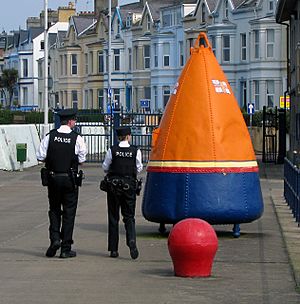
The PSNI uniform is bottle green. This colour is similar to the 'rifle green' used by the RUC before 2001. The Patten report suggested keeping the green uniform. When the new PSNI uniforms were introduced in 2002, the term 'bottle green' was used. This was to make the uniform seem less military-like.
In January 2022, a new uniform was introduced for officers on the front line. This new uniform replaced the white shirt and tie. Officers now wear a green t-shirt made of a special material. This shirt has the PSNI crest and the word "Police" on it. It also has epaulettes to show rank. This modern uniform is similar to those worn by other police forces in the UK.
Badge and Flag
| "The design of the emblem for the police is the design illustrated in Schedule 1 to these Regulations."
—Police Emblems and Flags Regulations (Northern Ireland) 2002, Section 3 |
|
|
The PSNI has a special flag and emblem. The emblem was designed to include symbols that represent different traditions in Northern Ireland. It has the St. Patrick's saltire, the Scales of Justice, a crown, a harp, a torch, an olive branch, and a shamrock.
The Police Emblems and Flags Regulations (Northern Ireland) 2002 state that only this flag can be used by the PSNI. It is the only flag allowed to be flown on any PSNI building, vehicle, aircraft, or boat.
The design of the emblem was agreed upon by a committee in 2001. It included symbols like the crown, harp, and shamrock. These symbols aimed to represent both sides of the community.
Police Equipment
Body Armour
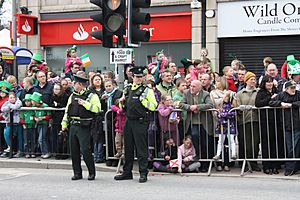
PSNI officers wear special vests called body armour. These vests have plates that can stop high-speed rifle bullets.
Since December 2007, officers in Greater Belfast and Greater Derry City areas have been required to wear body armour. This is because of safety concerns.
As of 2020, all officers are given ballistic body armour. In some safer areas, officers can choose to wear stab vests instead. These are similar to vests worn by most other UK police officers. In 2019, the PSNI started using a new, lighter body armour system.
Firearms
Unlike most police forces in the UK and Republic of Ireland, all PSNI officers carry firearms when on duty. They are also allowed to carry firearms when they are not working. This is because of the higher security risks in Northern Ireland.
The standard firearm for PSNI officers is the Glock 17 pistol. Every officer on patrol carries one. The PSNI also uses the Heckler & Koch G36K carbine as a primary long-arm weapon. Special riot guns are also available for crowd control.
Long-arm weapons are still commonly carried in areas with higher security threats. These areas include Derry, Belfast (especially north and west), and some border regions.
Vehicles

The most well-known PSNI vehicle is the Land Rover Tangi. This is an armoured vehicle that was used a lot during the time of conflict known as the Troubles. In 2011, some of these older vehicles were replaced. As of 2021, only a few of them were still in use. New armoured vehicles, like the OVIK PANGOLIN and Penman Public Order vehicles, have been brought in.
Today, the PSNI uses many regular vehicles for patrols. Their fleet has up to 2,690 vehicles. Most of these are marked and unmarked estate cars and SUVs. Some vehicles are armoured, meaning they have special panels and bulletproof windows. In November 2020, new Škoda Kodiaqs and Škoda Superbs were added to the fleet. The PSNI also uses BMW R1200RT motorcycles.
Besides cars, vans, and motorcycles, the PSNI also has 242 bicycles. These are used for patrols in city centres and on walkways.
Air Support
The PSNI has an Air Support Unit that helps with many police tasks. In 2014, this unit responded to over 4,000 calls. They helped with over 250 searches for missing people. All aircraft are used for investigations, fighting crime, managing traffic, and search and rescue. They also help with public order situations and tackling terrorism.
Helicopters
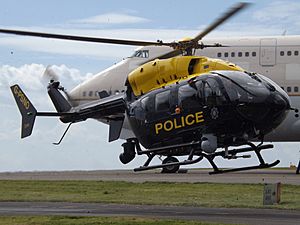
In May 2005, the PSNI received its first helicopter, a Eurocopter EC 135. In 2010, a second helicopter, a Eurocopter EC 145, was added. A third Eurocopter EC 145 helicopter joined the service in July 2013.
Fixed Wing Aircraft
The PSNI uses two fixed-wing aircraft for watching from the air. In August 1992, a Britten-Norman BN-2 Islander started service. In July 2011, this aircraft was damaged in a crash-landing. In June 2013, a Britten-Norman Defender 4000 joined the fleet.
For many years, the PSNI was the only UK police service that used fixed-wing aircraft. This changed in 2019 when the National Police Air Service bought four planes.
Other Equipment
Other items that PSNI officers use include:
- Folding Hiatt Speedcuffs (handcuffs)
- A Monadnock baton
- A First Aid pouch
- A TETRA radio for communication
- A torch with a traffic wand
- Limb-restraints, also known as fast-straps
Officers used to have BlackBerry devices. These have now been replaced with different models of Android smartphones. Since 2019, the service has been replacing CS spray with PAVA spray.
PSNI Headquarters
The main office for the PSNI is in Knock, an area in east Belfast. The Service's Museum has also been located there since the 1980s.
Data Breach and Fine in 2023
On August 8, 2023, the PSNI had a major data breach. Personal information for about 9,500 police officers and staff was accidentally put online. This happened when someone asked for information under a freedom of information request. The data included names, ranks, work locations, and departments for all PSNI employees.
On September 26, 2024, the UK Information Commissioner's Office (ICO) fined the PSNI £750,000. This fine was for breaking data protection laws. The ICO found that the PSNI did not have good enough ways to protect personal data. This was from May 2018 to June 2024.
The ICO said the data was very sensitive. This was especially true because of the security situation in Northern Ireland. They stated the breach "could lead to the most severe consequences imaginable for officers, staff and their families." The fine was reduced from a higher amount to £750,000.
Chief Constables of the PSNI
| No. | Name | From | To | Notes |
|---|---|---|---|---|
| 1 | Sir Ronnie Flanagan | November 2001 | March 2002 | He was the Chief Constable when the RUC became the PSNI. |
| – | Colin Cramphorn | March 2002 | September 2002 | Acting Chief Constable |
| 2 | Sir Hugh Orde | September 2002 | August 2009 | |
| – | Judith Gillespie | August 2009 | August 2009 | Acting Chief Constable |
| 3 | Sir Matt Baggott | August 2009 | June 2014 | |
| 4 | Sir George Hamilton | June 2014 | June 2019 | |
| 5 | Simon Byrne | June 2019 | September 2023 | He resigned after some issues. |
| – | Mark Hamilton | September 2023 | October 2023 | Acting Chief Constable |
| – | Jon Boutcher | October 2023 | November 2023 | Interim Chief Constable |
| 6 | Jon Boutcher | November 2023 | Incumbent |
Police Ranks
| Police Service of Northern Ireland ranks | |||||||||
|---|---|---|---|---|---|---|---|---|---|
| Rank | Chief constable | Deputy chief constable | Assistant chief constable | Chief superintendent | Superintendent | Chief inspector | Inspector | Sergeant | Constable |
| Epaulette insignia |  |
 |
 |
 |
 |
 |
 |
 |
 |
The PSNI has ranks similar to other UK police services. However, there are a few differences. Sergeants wear their chevrons pointing up, like in the United States. In other UK police forces, they point down. The PSNI badge's six-pointed star and saltire are used instead of a crown for some senior ranks. These include superintendents, chief superintendents, and the chief constable.
The rank badge for the chief constable is also different from other parts of the UK. It is similar to the Commissioner of Police in London.
Police Fund
The Police Fund was set up in 2002. It helps police officers and former officers who have been hurt or disabled by terrorist attacks. It also helps the families of officers who were killed or injured by terrorism.
See also
- List of law enforcement agencies in Northern Ireland
- Law enforcement in the United Kingdom
- List of Government departments and agencies in Northern Ireland
- Northern Ireland Security Guard Service
- PSNI F.C.
- PSNI GAA


